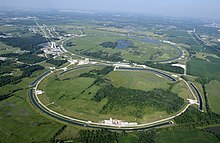Cooling pond
A cooling pond , depending on the type and size also cooling water , cooling or Kühlsee , reservior , basins or -weiher called, is a pond , in which heated cooling water from thermal power plants and thermal industrial equipment is cooled down again. The waste heat is given off to the surrounding earth's atmosphere through convection and evaporation on the water surface .
use
The advantage over the cooling tower lies primarily in the far lower water loss through steam plumes , in the lower pressure loss and thus lower energy consumption for pumping the cooling water and in the fact that the chemical composition of the cooling water hardly changes. That is why cooling ponds are also used as the last stage in sewage treatment plants .
The nuclear power plants in Eastern Europe use the cooling ponds , which are many hundred hectares in size and typically 2 m deep, for a completely different reason: in the event of a nuclear accident, several million cubic meters of water are stored there , which can be used to cool an atomic fission process that has gotten out of control this cooling water would have to be taken from a flowing water . Any radioactive contamination of the cooling water could thus be limited to the area of the cooling pond and the immediate surroundings, but in the long term it would lead to groundwater problems.
Cooling ponds usually also function as extinguishing water ponds and sometimes also as extinguishing water retention basins .
Ecological consequences

Cooling ponds are mostly artificially created bodies of water, because the heat input leads to a significant warming of the water, which in a natural body of water leads to a massive change in the ecosystem. Since this contradicts water protection , the use of natural standing water for cooling purposes is generally not permitted in most countries; only rivers may be used, although the permissible warming is limited in the permit.
On the other hand, valuable secondary biotopes with a unique fauna and flora that are adapted or bound to the increased temperature often form in the long term in cooling ponds that are laid out close to nature .

